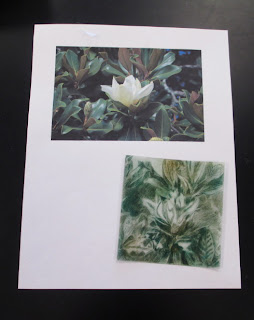Clearly, I could practice just using a lighter touch and sharper pencils! However, today I wanted to try out a little mixed media technique and lay down a watercolor wash to give me some background on top of which to add pencil.
One of my retreat friends used this technique beautifully this weekend while painting a skunk cabbage in all of its maroon and cream glory. It reminded me that although I have not done much painting with watercolor, I could definitely use it as a base for a detailed colored pencil drawing, especially when layering very light colors with darker ones.
I started out with a light graphite pencil sketch to get the shapes. I have a small Windsor & Newton travel watercolor kit and used one of my travel watercolor brushes to grab a little bit of yellow and do a light wash on the petals. I also did the same with a light wash of green on the stem and leaves.
I painted on Fabriano Artistico Extra White hot press watercolor paper. I took some quick snapshots to show the process, but apologize for the poor quality of the photos! It should give you an idea of how I worked through the study, at least.
Next, I started adding in layers of colored pencil. I use Faber-Castell Polychromos pencils. For this particular study, I used dark red for the deepest shadows in the petals and layered deep scarlet red and pale geranium lake on top for the red sections. For the yellow, I added some shadows with light yellow ochre and dark naples ochre. I kept layering, attempting to capture the subtle texture of these silky petals.

I used light green, permanent green, may green, and pine green for the leaves and stem.
As you can see below in the photo of my whole page, I did some test patches for each pencil before I used them to make sure I had the right colors. I need to do a color chart of all of my pencils to use as a reference! Those can be fun to make and good pencil practice - perhaps another blog post?
When I finished, I set the drawing aside for a few minutes and came back to it, darkening some shadows for definition and adding some highlights with my kneaded eraser. Here is the final. It's a photo (couldn't get the scan to look right) and even this doesn't quite show the darker reds as much as the actual.
Overall, I really liked using a watercolor wash as a base. I have more practicing to do, but look forward to using this technique again.
Do you use mixed media in your work? What combinations do you like and why?




















